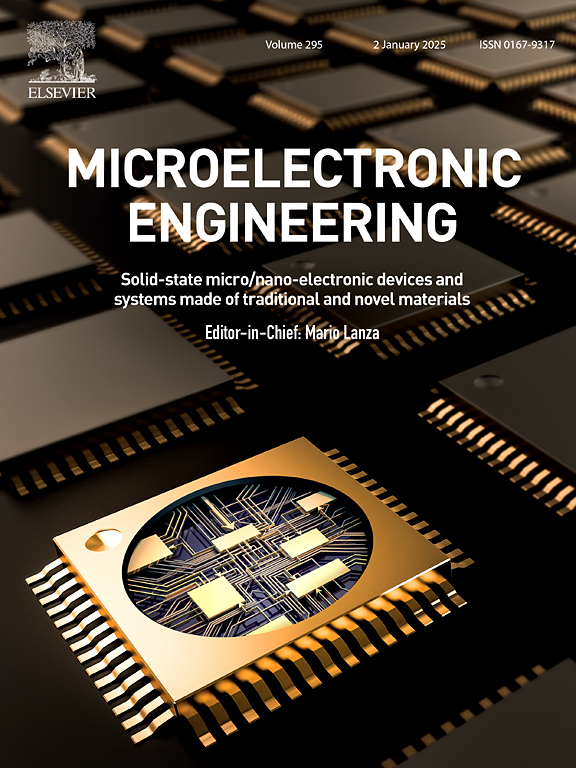Measurement of the lithographic point-spread function of a focused helium ion beam in negative-tone PMMA and fullerene resists on ultrathin membranes
IF 3.1
4区 工程技术
Q2 ENGINEERING, ELECTRICAL & ELECTRONIC
引用次数: 0
Abstract
Helium-ion-beam lithography has many advantages relevant to the fabrication of dense arrays of nanostructures such as a small probe size, large depth of field, and reduced proximity effect. Here, we calculate and measure the lithographic point-spread functions (PSFs) of 30 keV He ions in negative-tone polymethyl methacrylate (PMMA) and a fullerene-derivative resist on ultrathin silicon nitride membranes and compare the results to similar work by Manfrinato et al. (2017) measuring the PSF of 200 keV electrons in PMMA using an aberration-corrected scanning transmission electron microscope (STEM). PSFs were calculated using the method reported previously by Winston et al. (2012). Our results show that both the He ion/PMMA and He ion/fullerene-derivative resist PSFs decay more rapidly with distance, r, from the point of incidence of the beam than the corresponding aberration-corrected electron beam/PMMA PSF. In fact, the He ion PSFs decay approximately with r−4 while the aberration-corrected EBL PSF decays approximately with r−2. This result implies that the lateral area exposed by the focused beam increases more rapidly with dose for e beams than He beams. Effectively, this should result in reduced proximity effect in helium-ion-beam lithography. This work provides further evidence that HIBL offers distinct advantages over EBL for high-resolution and high-density patterning as well as highlighting some benefits of the fullerene-derivative resist over PMMA.

负调聚甲基丙烯酸甲酯和富勒烯薄膜上聚焦氦离子束光刻点扩散函数的测量
氦离子束光刻技术在制备致密纳米结构阵列方面具有探针尺寸小、景深大、接近效应小等优点。在这里,我们计算和测量了30 keV He+离子在负调聚甲基丙烯酸甲酯(PMMA)和超薄氮化硅膜上的光刻点扩展函数(PSF),并将结果与Manfrinato等人(2017)使用像差校正扫描透射电子显微镜(STEM)测量PMMA中200 keV电子的PSF的类似工作进行了比较。使用Winston等人(2012)先前报道的方法计算psf。我们的研究结果表明,He+离子/PMMA和He+离子/富勒烯衍生物抵抗PSF比相应的经像差校正的电子束/PMMA PSF在距离入射点r处更快地衰减。事实上,He+离子PSF大约随r−4衰减,而像差校正的EBL PSF大约随r−2衰减。这一结果表明,与He+光束相比,e−光束的侧边暴露面积随剂量的增加更快。有效地,这将导致减少接近效应在氦离子束光刻。这项工作提供了进一步的证据,证明HIBL在高分辨率和高密度图案方面比EBL具有明显的优势,同时也突出了富勒烯衍生物抗胶剂相对于PMMA的一些优势。
本文章由计算机程序翻译,如有差异,请以英文原文为准。
求助全文
约1分钟内获得全文
求助全文
来源期刊

Microelectronic Engineering
工程技术-工程:电子与电气
CiteScore
5.30
自引率
4.30%
发文量
131
审稿时长
29 days
期刊介绍:
Microelectronic Engineering is the premier nanoprocessing, and nanotechnology journal focusing on fabrication of electronic, photonic, bioelectronic, electromechanic and fluidic devices and systems, and their applications in the broad areas of electronics, photonics, energy, life sciences, and environment. It covers also the expanding interdisciplinary field of "more than Moore" and "beyond Moore" integrated nanoelectronics / photonics and micro-/nano-/bio-systems. Through its unique mixture of peer-reviewed articles, reviews, accelerated publications, short and Technical notes, and the latest research news on key developments, Microelectronic Engineering provides comprehensive coverage of this exciting, interdisciplinary and dynamic new field for researchers in academia and professionals in industry.
 求助内容:
求助内容: 应助结果提醒方式:
应助结果提醒方式:


